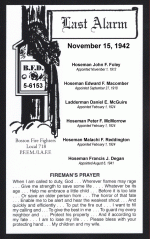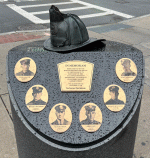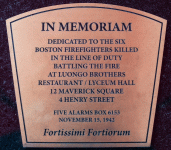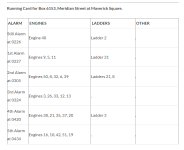
The Maverick Square Fire of 1942
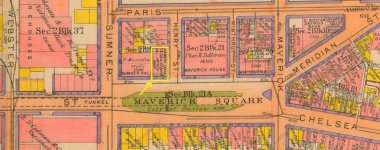
Map of Maverick Square, East Boston, showing the location of the fire.
This page tells the tragic story of the Maverick Square Fire and Collapse, which occurred in the early morning hours of November 15, 1942. The fire in Luongo’s Tap, a restaurant within the former East Boston Lyceum, quickly escalated to 3 alarms. Later, without warning, the brick wall from the 3rd, 4th and 5th floors on the Henry Street side of the building collapsed burying many firefighters in the rubble. 4th and 5th alarms were transmitted. Also buried in the rubble was Ladder 8’s 125ft aerial ladder truck, the only white-colored apparatus in the history of the Boston Fire Department. This rig became known as the ‘White Elephant’ due to its checkered history of service.
Nearly fifty firefighters were injured or trapped in the collapse. Upon removal of all firefighters present at the scene, six died as a result of their injuries. The six firemen killed in the Line Of Duty at the scene equaled the record number of Line Of Duty deaths suffered by the Boston Fire Department at a single incident in the Department’s history. That incident was the
Merrimac Street Fire and Collapse of 1898.
The fire took place in a 5&1/2-story, 35ft x 65ft, 2nd class brick building housing a liquor store on the first floor, and a tavern and restaurant on the first and upper floors. The building was owned by Ralph Luongo and John & Raffaelle Luongo. The liquor store was operated by Arthur Pilato and John Fronduto. A dine & dance cafe was located on the second floor. Over 200 couples were in attendance in the cafe when it closed for the evening at midnight.
The fire originated in the ceiling above the kitchen on the first floor. The fire extended throughout the entire building and extended to an adjoining building, a 3-story, 20ft x 40ft, 2nd class brick building at 10 Henry Street. That building was owned by Concetta Sennato.
The Boston Fire Department transmitted a Still Alarm at 0226 hours for Engine Company 40 and Ladder Company 2 to respond. Box 6153, Meridian Street at Maverick Square, was transmitted at 0227 hours. Engine Company 9, Engine Company 5, Engine Company 11, Ladder Company 31 and the Acting District Chief Jacob Berninger of District 1 responded to fill out the full First Alarm assignment.
A 2nd Alarm was transmitted by District Chief Crowley at 0305 hours. A 3rd Alarm was transmitted by Deputy Chief Louis Stickel at 0324 hours. Moments later, at approximately 0400 hours, without warning, the brick wall on the Henry Street side of the collapsed. There was no buckling of the wall prior to the collapse. Many firefighters were trapped in the interior of the building and the ladder truck of Ladder 8 was crushed beneath the debris. Rescue operations ensued immediately, which were affected by the +12 degree temperature and stiff winds. Chief of Department Samuel Pope ordered a 4th Alarm at 0420 hours and a 5th Alarm at 0434 hours. A call for assistance went out to military forces and request for a crane. The Boston Globe reported 175 Marines, Coast Guardsmen and police officers and three cranes aided Boston firemen in the rescue effort.
The aerial ladder of the crushed ladder truck was used as an escape route from the rubble, as well as a platform from which the long task of dig-out and rescue was performed. Hoseman Macomber’s body was the first to be removed, at approximately 0900 hours. At 1330 hours, Hoseman Degan’s body was removed. Hoseman Reddington was removed alive and transported to Boston City Hospital, where he expired during the evening hours. Hoseman McMorrow’s body was found at 1600 hours, followed shortly thereafter, at 1630 hours, with the discovery of Ladderman McGuire’s body.
Hoseman Foley’s body was found at 2145 hours by Coast Guard Seaman Burton Rought and Chief Boatswain’s Mate A.P. Brooks, a former Boston fireman. At 2215 hours, Hoseman Foley was the last firefighter removed that evening, 18 hours after the collapse. The All-Out was sent at 2331 hours. The tragedy left six firemen dead and forty-five firemen injured.
Several investigations into the fire and collapse began immediately. The Fire Department’s Fire Prevention Bureau, the Police Department’ Arson Squad, and state’s Fire Marshal’s Office each initiated probes. A victim’s aid fund was established and many contributions were received from throughout the Greater Boston area. Under state law, annuities of $1000 to each of the widows and $250 to each of the children were granted.


